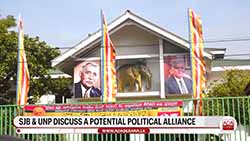Why Sri Lanka has done a China-style ‘managed float’
September 7, 2015 01:36 pm
Sri Lanka’s central bank is allowing the local rupee to become more market-oriented but like Bejing, it has shied away from turning the currency into a true free float.
The Central Bank of Sri Lanka (CBSL) said on Friday that it would stop quoting a reference rate for the currency, letting markets determine the rate instead, as sliding foreign reserves and weak exports worry officials.
“The sharp decline in Sri Lanka’s foreign exchange reserves during 2015 has forced the central bank to stop intervening to stabilize the currency,” Rajiv Biswas, Asia-Pacific chief economist at IHS, told CNBC on Monday.
Reserves dropped by $638 million on-month to $6.8 billion in July, down from $9.18 billion in August 2014, and only a modest recovery is expected going forward after a recent $1.1 billion currency swap agreement with the Reserve Bank of India.
“This is a welcome and overdue move...Given Sri Lanka’s relatively low reserve cover, a FX peg is clearly unsustainable,” Citi economist Johanna Chu noted on Monday.
However, the CBSL said it would still intervene when necessary to cap excessive volatility and prevent a depreciation free-fall, similar to China’s current system that traders call the ‘managed float.’
The Sri Lankan rupee has lost 3 percent against the greenback since Beijing’s landmark announcement to devalue the yuan one month ago. China is Sri Lanka’s top investor and second-largest trading partner so a cheaper yuan hurts Sri Lankan goods.
Emerging markets Vietnam and Kazakhstan have announced similar moves in the past month in an effort to prop up their economies, which are being buffeted by China’s yuan depreciation, slumping commodity prices and investment outflows ahead of a potential U.S. interest rate hike.
“We’re looking to liberate the currency markets,” Arjuna Mahendran, CBSL governor, told CNBC last week. “In the past, we had a quasi-Chinese system where prices were controlled. The government’s plan is to move that into a market-driven fashion, so we can respond to international price movements and absorb any external punches.”
Aside from declining reserves, capital flows were a key factor behind Friday’s decision. Foreign holdings of rupee-denominated Treasury securities declined by $740 million in the past three months, according to Citi data.
Moreover, political stability has returned with the formation of a new unity government under President Maithripala Sirisena and Prime Minister Ranil Wickremesinghe following general elections last month.
Investors may welcome Friday’s decision, but officials still have plenty of work cut out for them.
“With [foreign currency] interest payments consuming over a third of revenues, the government will likely need to impose tighter fiscal (and monetary) policies to avert a negative vicious spiral,” Chu noted, referring to the possibility Sri Lanka could be forced to issue bonds in order to pay the coupons on existing bonds.
Sri Lanka has the region’s highest government debt at 72 of gross domestic product, 40 percent of which is foreign.
So, where now for the currency? Gradually lower, it seems.
But because of its high debt burden, Colombo will unlikely be able to tolerate significant currency depreciation and thus will be forced to intervene regularly, according to Chu.
Meanwhile, Biswas of IHS believes the rupee remains vulnerable to further downside pressures in coming months as global investors continue reallocating assets out of emerging markets. – (Courtesy - CNBC)












